Customer Experience Management: CUA Bank Case Study Analysis
VerifiedAdded on 2020/04/21
|10
|2206
|98
Case Study
AI Summary
This case study analyzes customer experience management (CEM) at Credit Union Australia (CUA) bank, focusing on service delivery challenges and opportunities. The study begins with a personal experience of slow service during online banking activation, which prompted a survey of CUA customers. The survey revealed that while a majority of long-term customers (over 5 years) are averagely satisfied, there are pain points such as long queues in banking halls and slow email response times. The study then explores the IDIC model (Identify, Differentiate, Interact, Customize) as a framework for improving customer experience, emphasizing the importance of touchpoints like social media. The analysis highlights the current state of service experience at CUA, emphasizing the need to address process inefficiencies to reduce customer churn, improve loyalty, and enhance the bank's market position. The study concludes by emphasizing the significance of addressing pain points and leveraging customer feedback to improve service delivery and overall customer satisfaction.
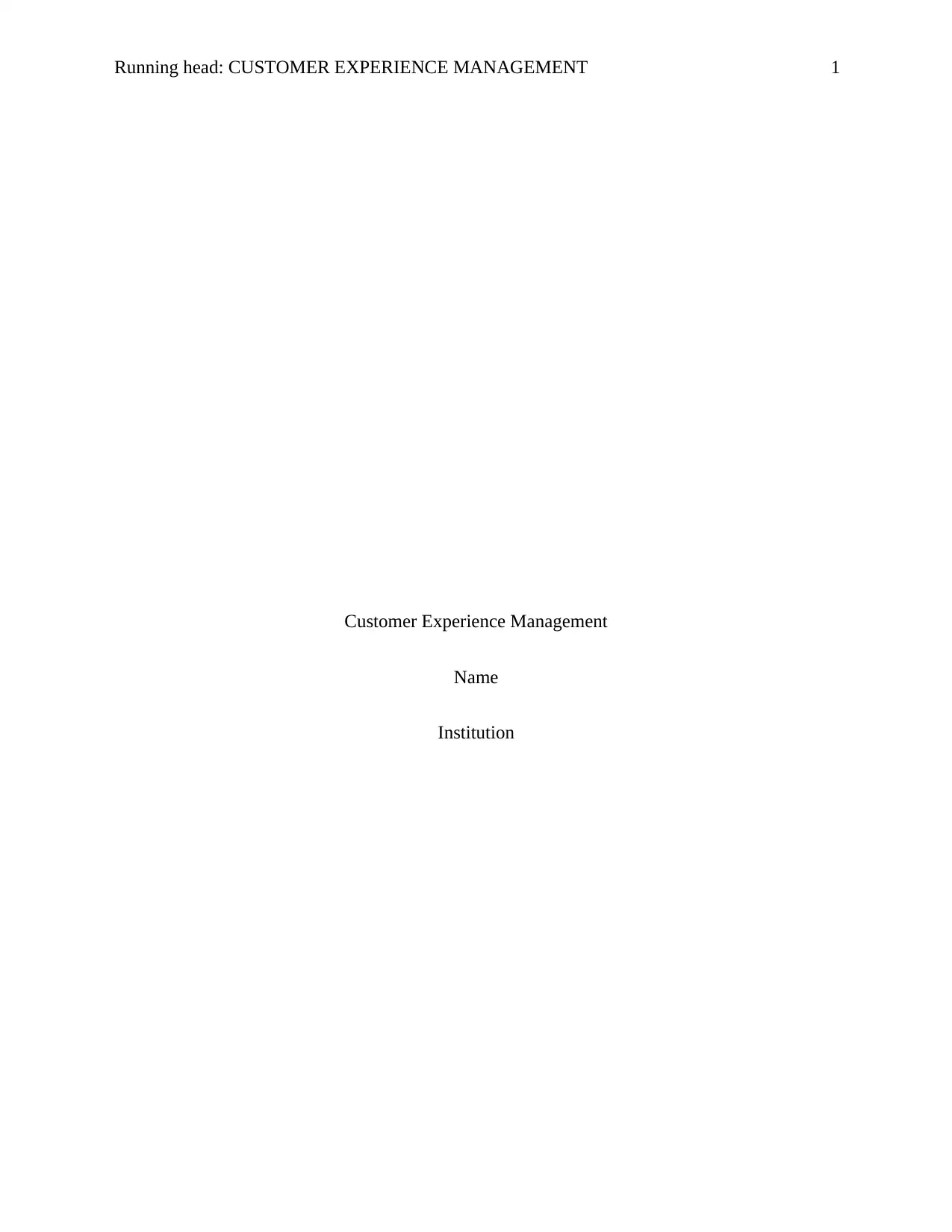
Running head: CUSTOMER EXPERIENCE MANAGEMENT 1
Customer Experience Management
Name
Institution
Customer Experience Management
Name
Institution
Paraphrase This Document
Need a fresh take? Get an instant paraphrase of this document with our AI Paraphraser
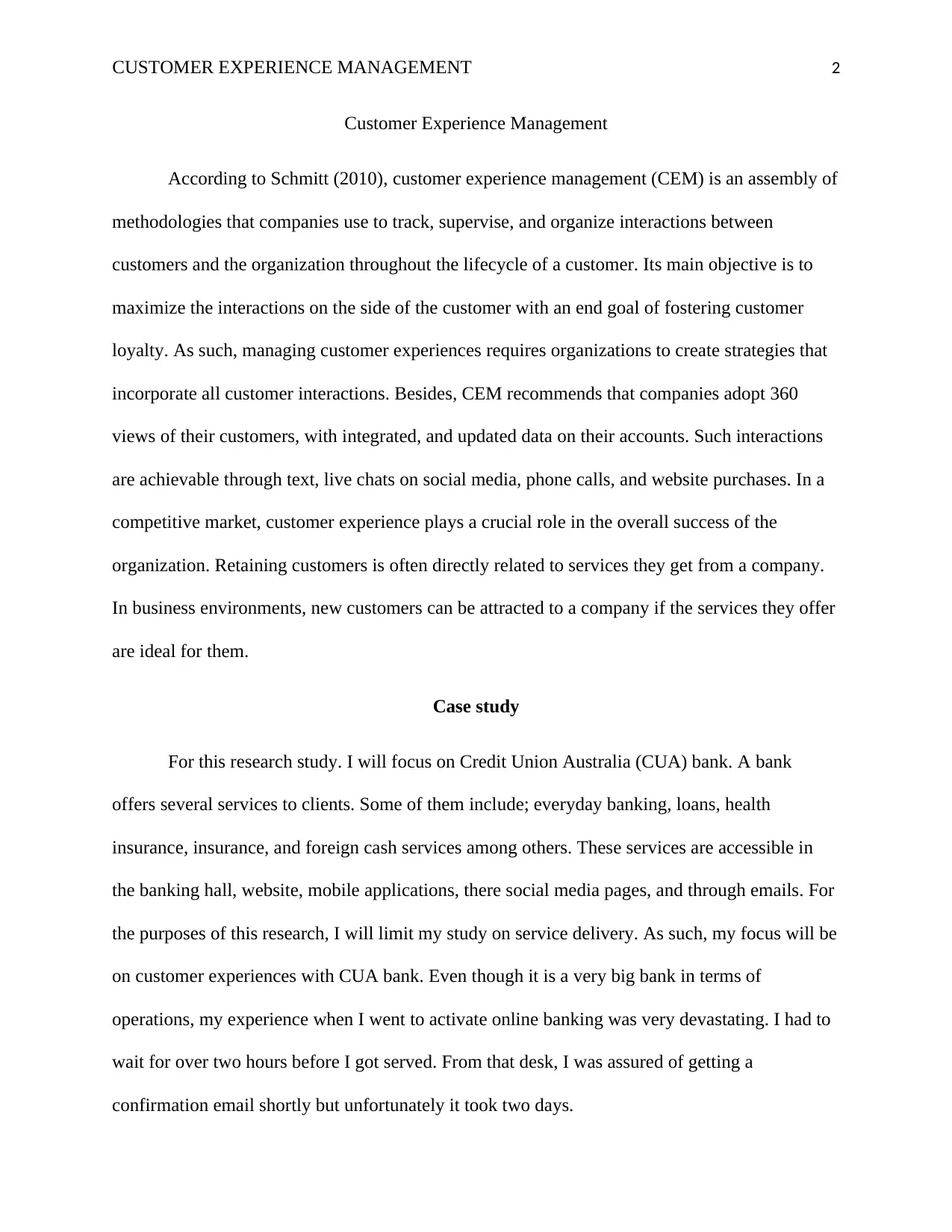
CUSTOMER EXPERIENCE MANAGEMENT 2
Customer Experience Management
According to Schmitt (2010), customer experience management (CEM) is an assembly of
methodologies that companies use to track, supervise, and organize interactions between
customers and the organization throughout the lifecycle of a customer. Its main objective is to
maximize the interactions on the side of the customer with an end goal of fostering customer
loyalty. As such, managing customer experiences requires organizations to create strategies that
incorporate all customer interactions. Besides, CEM recommends that companies adopt 360
views of their customers, with integrated, and updated data on their accounts. Such interactions
are achievable through text, live chats on social media, phone calls, and website purchases. In a
competitive market, customer experience plays a crucial role in the overall success of the
organization. Retaining customers is often directly related to services they get from a company.
In business environments, new customers can be attracted to a company if the services they offer
are ideal for them.
Case study
For this research study. I will focus on Credit Union Australia (CUA) bank. A bank
offers several services to clients. Some of them include; everyday banking, loans, health
insurance, insurance, and foreign cash services among others. These services are accessible in
the banking hall, website, mobile applications, there social media pages, and through emails. For
the purposes of this research, I will limit my study on service delivery. As such, my focus will be
on customer experiences with CUA bank. Even though it is a very big bank in terms of
operations, my experience when I went to activate online banking was very devastating. I had to
wait for over two hours before I got served. From that desk, I was assured of getting a
confirmation email shortly but unfortunately it took two days.
Customer Experience Management
According to Schmitt (2010), customer experience management (CEM) is an assembly of
methodologies that companies use to track, supervise, and organize interactions between
customers and the organization throughout the lifecycle of a customer. Its main objective is to
maximize the interactions on the side of the customer with an end goal of fostering customer
loyalty. As such, managing customer experiences requires organizations to create strategies that
incorporate all customer interactions. Besides, CEM recommends that companies adopt 360
views of their customers, with integrated, and updated data on their accounts. Such interactions
are achievable through text, live chats on social media, phone calls, and website purchases. In a
competitive market, customer experience plays a crucial role in the overall success of the
organization. Retaining customers is often directly related to services they get from a company.
In business environments, new customers can be attracted to a company if the services they offer
are ideal for them.
Case study
For this research study. I will focus on Credit Union Australia (CUA) bank. A bank
offers several services to clients. Some of them include; everyday banking, loans, health
insurance, insurance, and foreign cash services among others. These services are accessible in
the banking hall, website, mobile applications, there social media pages, and through emails. For
the purposes of this research, I will limit my study on service delivery. As such, my focus will be
on customer experiences with CUA bank. Even though it is a very big bank in terms of
operations, my experience when I went to activate online banking was very devastating. I had to
wait for over two hours before I got served. From that desk, I was assured of getting a
confirmation email shortly but unfortunately it took two days.
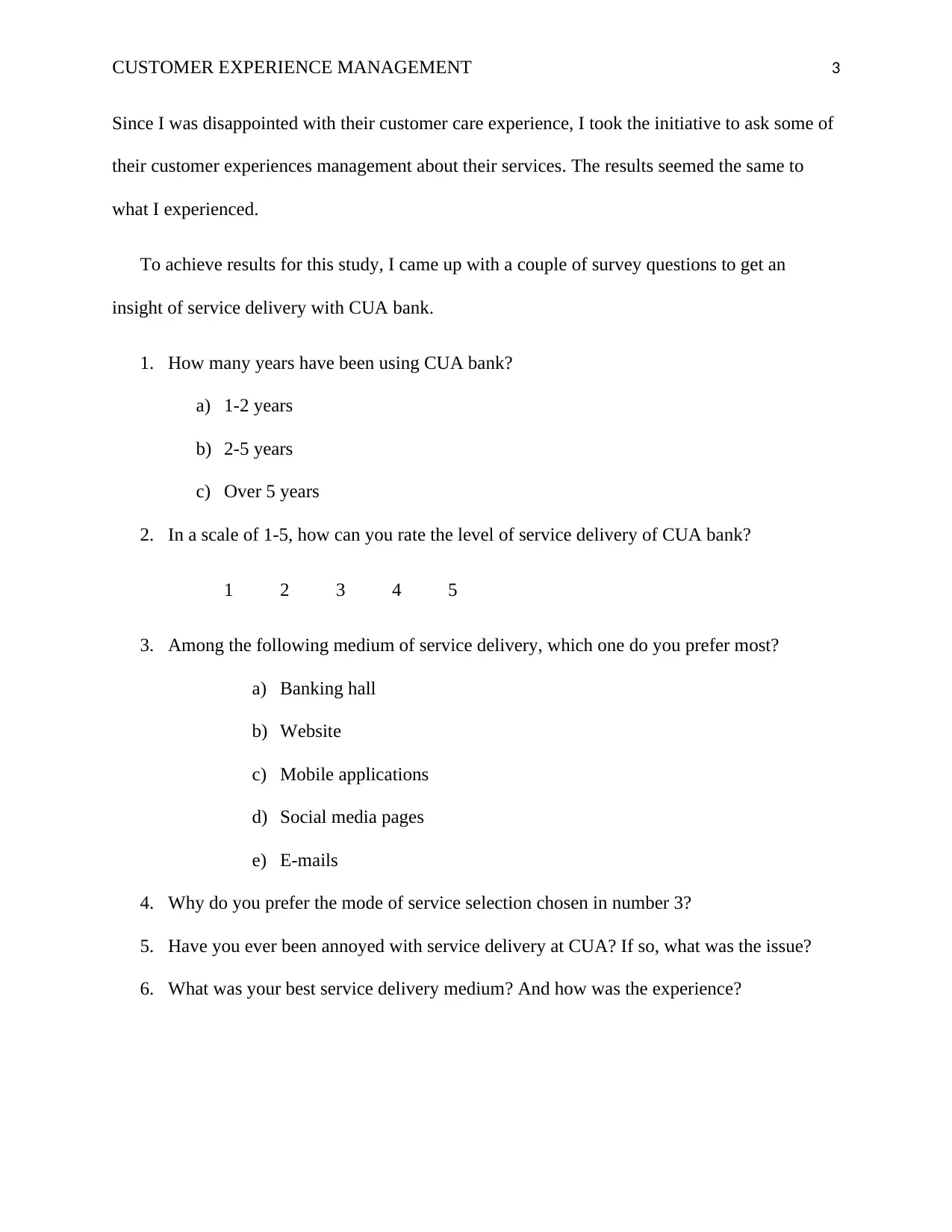
CUSTOMER EXPERIENCE MANAGEMENT 3
Since I was disappointed with their customer care experience, I took the initiative to ask some of
their customer experiences management about their services. The results seemed the same to
what I experienced.
To achieve results for this study, I came up with a couple of survey questions to get an
insight of service delivery with CUA bank.
1. How many years have been using CUA bank?
a) 1-2 years
b) 2-5 years
c) Over 5 years
2. In a scale of 1-5, how can you rate the level of service delivery of CUA bank?
1 2 3 4 5
3. Among the following medium of service delivery, which one do you prefer most?
a) Banking hall
b) Website
c) Mobile applications
d) Social media pages
e) E-mails
4. Why do you prefer the mode of service selection chosen in number 3?
5. Have you ever been annoyed with service delivery at CUA? If so, what was the issue?
6. What was your best service delivery medium? And how was the experience?
Since I was disappointed with their customer care experience, I took the initiative to ask some of
their customer experiences management about their services. The results seemed the same to
what I experienced.
To achieve results for this study, I came up with a couple of survey questions to get an
insight of service delivery with CUA bank.
1. How many years have been using CUA bank?
a) 1-2 years
b) 2-5 years
c) Over 5 years
2. In a scale of 1-5, how can you rate the level of service delivery of CUA bank?
1 2 3 4 5
3. Among the following medium of service delivery, which one do you prefer most?
a) Banking hall
b) Website
c) Mobile applications
d) Social media pages
e) E-mails
4. Why do you prefer the mode of service selection chosen in number 3?
5. Have you ever been annoyed with service delivery at CUA? If so, what was the issue?
6. What was your best service delivery medium? And how was the experience?
⊘ This is a preview!⊘
Do you want full access?
Subscribe today to unlock all pages.

Trusted by 1+ million students worldwide
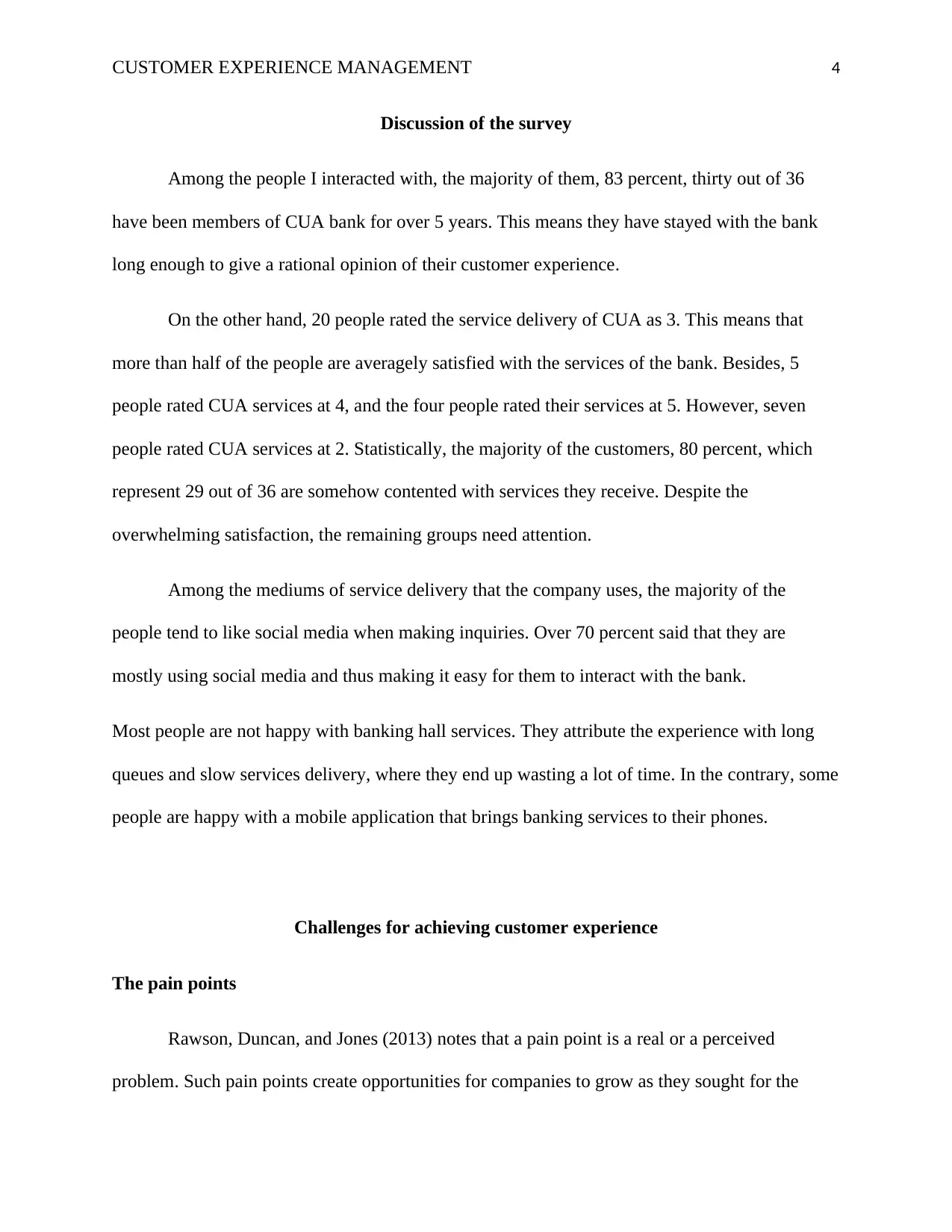
CUSTOMER EXPERIENCE MANAGEMENT 4
Discussion of the survey
Among the people I interacted with, the majority of them, 83 percent, thirty out of 36
have been members of CUA bank for over 5 years. This means they have stayed with the bank
long enough to give a rational opinion of their customer experience.
On the other hand, 20 people rated the service delivery of CUA as 3. This means that
more than half of the people are averagely satisfied with the services of the bank. Besides, 5
people rated CUA services at 4, and the four people rated their services at 5. However, seven
people rated CUA services at 2. Statistically, the majority of the customers, 80 percent, which
represent 29 out of 36 are somehow contented with services they receive. Despite the
overwhelming satisfaction, the remaining groups need attention.
Among the mediums of service delivery that the company uses, the majority of the
people tend to like social media when making inquiries. Over 70 percent said that they are
mostly using social media and thus making it easy for them to interact with the bank.
Most people are not happy with banking hall services. They attribute the experience with long
queues and slow services delivery, where they end up wasting a lot of time. In the contrary, some
people are happy with a mobile application that brings banking services to their phones.
Challenges for achieving customer experience
The pain points
Rawson, Duncan, and Jones (2013) notes that a pain point is a real or a perceived
problem. Such pain points create opportunities for companies to grow as they sought for the
Discussion of the survey
Among the people I interacted with, the majority of them, 83 percent, thirty out of 36
have been members of CUA bank for over 5 years. This means they have stayed with the bank
long enough to give a rational opinion of their customer experience.
On the other hand, 20 people rated the service delivery of CUA as 3. This means that
more than half of the people are averagely satisfied with the services of the bank. Besides, 5
people rated CUA services at 4, and the four people rated their services at 5. However, seven
people rated CUA services at 2. Statistically, the majority of the customers, 80 percent, which
represent 29 out of 36 are somehow contented with services they receive. Despite the
overwhelming satisfaction, the remaining groups need attention.
Among the mediums of service delivery that the company uses, the majority of the
people tend to like social media when making inquiries. Over 70 percent said that they are
mostly using social media and thus making it easy for them to interact with the bank.
Most people are not happy with banking hall services. They attribute the experience with long
queues and slow services delivery, where they end up wasting a lot of time. In the contrary, some
people are happy with a mobile application that brings banking services to their phones.
Challenges for achieving customer experience
The pain points
Rawson, Duncan, and Jones (2013) notes that a pain point is a real or a perceived
problem. Such pain points create opportunities for companies to grow as they sought for the
Paraphrase This Document
Need a fresh take? Get an instant paraphrase of this document with our AI Paraphraser
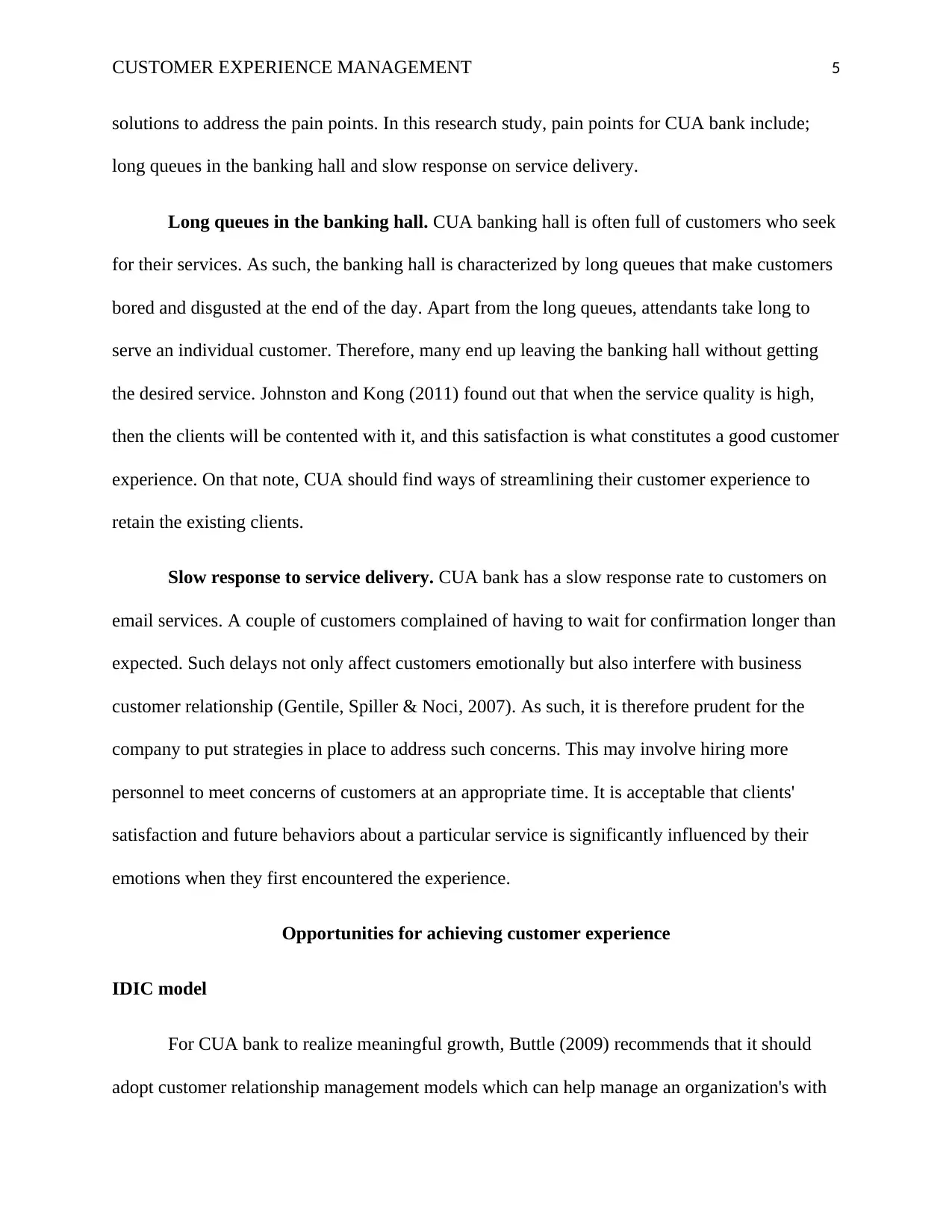
CUSTOMER EXPERIENCE MANAGEMENT 5
solutions to address the pain points. In this research study, pain points for CUA bank include;
long queues in the banking hall and slow response on service delivery.
Long queues in the banking hall. CUA banking hall is often full of customers who seek
for their services. As such, the banking hall is characterized by long queues that make customers
bored and disgusted at the end of the day. Apart from the long queues, attendants take long to
serve an individual customer. Therefore, many end up leaving the banking hall without getting
the desired service. Johnston and Kong (2011) found out that when the service quality is high,
then the clients will be contented with it, and this satisfaction is what constitutes a good customer
experience. On that note, CUA should find ways of streamlining their customer experience to
retain the existing clients.
Slow response to service delivery. CUA bank has a slow response rate to customers on
email services. A couple of customers complained of having to wait for confirmation longer than
expected. Such delays not only affect customers emotionally but also interfere with business
customer relationship (Gentile, Spiller & Noci, 2007). As such, it is therefore prudent for the
company to put strategies in place to address such concerns. This may involve hiring more
personnel to meet concerns of customers at an appropriate time. It is acceptable that clients'
satisfaction and future behaviors about a particular service is significantly influenced by their
emotions when they first encountered the experience.
Opportunities for achieving customer experience
IDIC model
For CUA bank to realize meaningful growth, Buttle (2009) recommends that it should
adopt customer relationship management models which can help manage an organization's with
solutions to address the pain points. In this research study, pain points for CUA bank include;
long queues in the banking hall and slow response on service delivery.
Long queues in the banking hall. CUA banking hall is often full of customers who seek
for their services. As such, the banking hall is characterized by long queues that make customers
bored and disgusted at the end of the day. Apart from the long queues, attendants take long to
serve an individual customer. Therefore, many end up leaving the banking hall without getting
the desired service. Johnston and Kong (2011) found out that when the service quality is high,
then the clients will be contented with it, and this satisfaction is what constitutes a good customer
experience. On that note, CUA should find ways of streamlining their customer experience to
retain the existing clients.
Slow response to service delivery. CUA bank has a slow response rate to customers on
email services. A couple of customers complained of having to wait for confirmation longer than
expected. Such delays not only affect customers emotionally but also interfere with business
customer relationship (Gentile, Spiller & Noci, 2007). As such, it is therefore prudent for the
company to put strategies in place to address such concerns. This may involve hiring more
personnel to meet concerns of customers at an appropriate time. It is acceptable that clients'
satisfaction and future behaviors about a particular service is significantly influenced by their
emotions when they first encountered the experience.
Opportunities for achieving customer experience
IDIC model
For CUA bank to realize meaningful growth, Buttle (2009) recommends that it should
adopt customer relationship management models which can help manage an organization's with
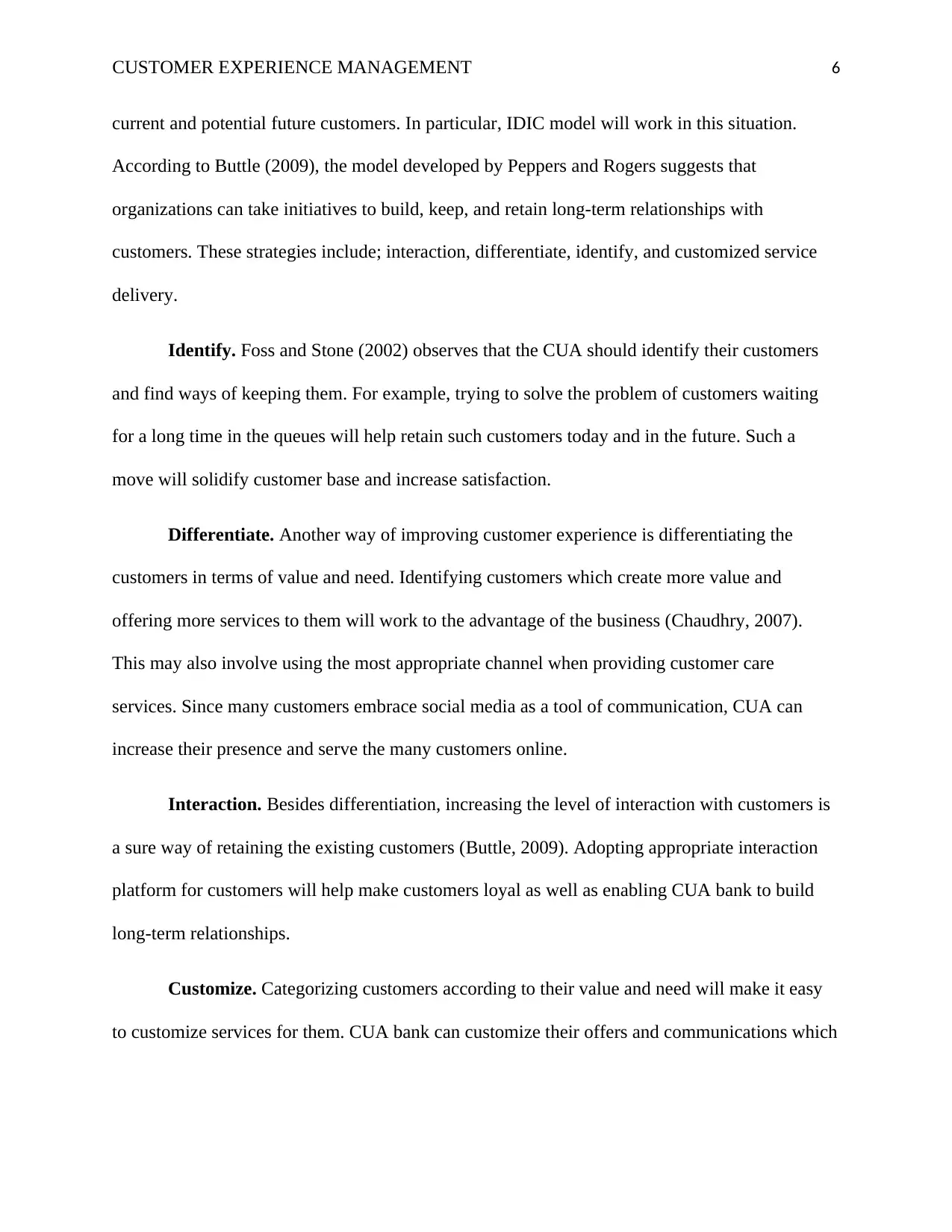
CUSTOMER EXPERIENCE MANAGEMENT 6
current and potential future customers. In particular, IDIC model will work in this situation.
According to Buttle (2009), the model developed by Peppers and Rogers suggests that
organizations can take initiatives to build, keep, and retain long-term relationships with
customers. These strategies include; interaction, differentiate, identify, and customized service
delivery.
Identify. Foss and Stone (2002) observes that the CUA should identify their customers
and find ways of keeping them. For example, trying to solve the problem of customers waiting
for a long time in the queues will help retain such customers today and in the future. Such a
move will solidify customer base and increase satisfaction.
Differentiate. Another way of improving customer experience is differentiating the
customers in terms of value and need. Identifying customers which create more value and
offering more services to them will work to the advantage of the business (Chaudhry, 2007).
This may also involve using the most appropriate channel when providing customer care
services. Since many customers embrace social media as a tool of communication, CUA can
increase their presence and serve the many customers online.
Interaction. Besides differentiation, increasing the level of interaction with customers is
a sure way of retaining the existing customers (Buttle, 2009). Adopting appropriate interaction
platform for customers will help make customers loyal as well as enabling CUA bank to build
long-term relationships.
Customize. Categorizing customers according to their value and need will make it easy
to customize services for them. CUA bank can customize their offers and communications which
current and potential future customers. In particular, IDIC model will work in this situation.
According to Buttle (2009), the model developed by Peppers and Rogers suggests that
organizations can take initiatives to build, keep, and retain long-term relationships with
customers. These strategies include; interaction, differentiate, identify, and customized service
delivery.
Identify. Foss and Stone (2002) observes that the CUA should identify their customers
and find ways of keeping them. For example, trying to solve the problem of customers waiting
for a long time in the queues will help retain such customers today and in the future. Such a
move will solidify customer base and increase satisfaction.
Differentiate. Another way of improving customer experience is differentiating the
customers in terms of value and need. Identifying customers which create more value and
offering more services to them will work to the advantage of the business (Chaudhry, 2007).
This may also involve using the most appropriate channel when providing customer care
services. Since many customers embrace social media as a tool of communication, CUA can
increase their presence and serve the many customers online.
Interaction. Besides differentiation, increasing the level of interaction with customers is
a sure way of retaining the existing customers (Buttle, 2009). Adopting appropriate interaction
platform for customers will help make customers loyal as well as enabling CUA bank to build
long-term relationships.
Customize. Categorizing customers according to their value and need will make it easy
to customize services for them. CUA bank can customize their offers and communications which
⊘ This is a preview!⊘
Do you want full access?
Subscribe today to unlock all pages.

Trusted by 1+ million students worldwide
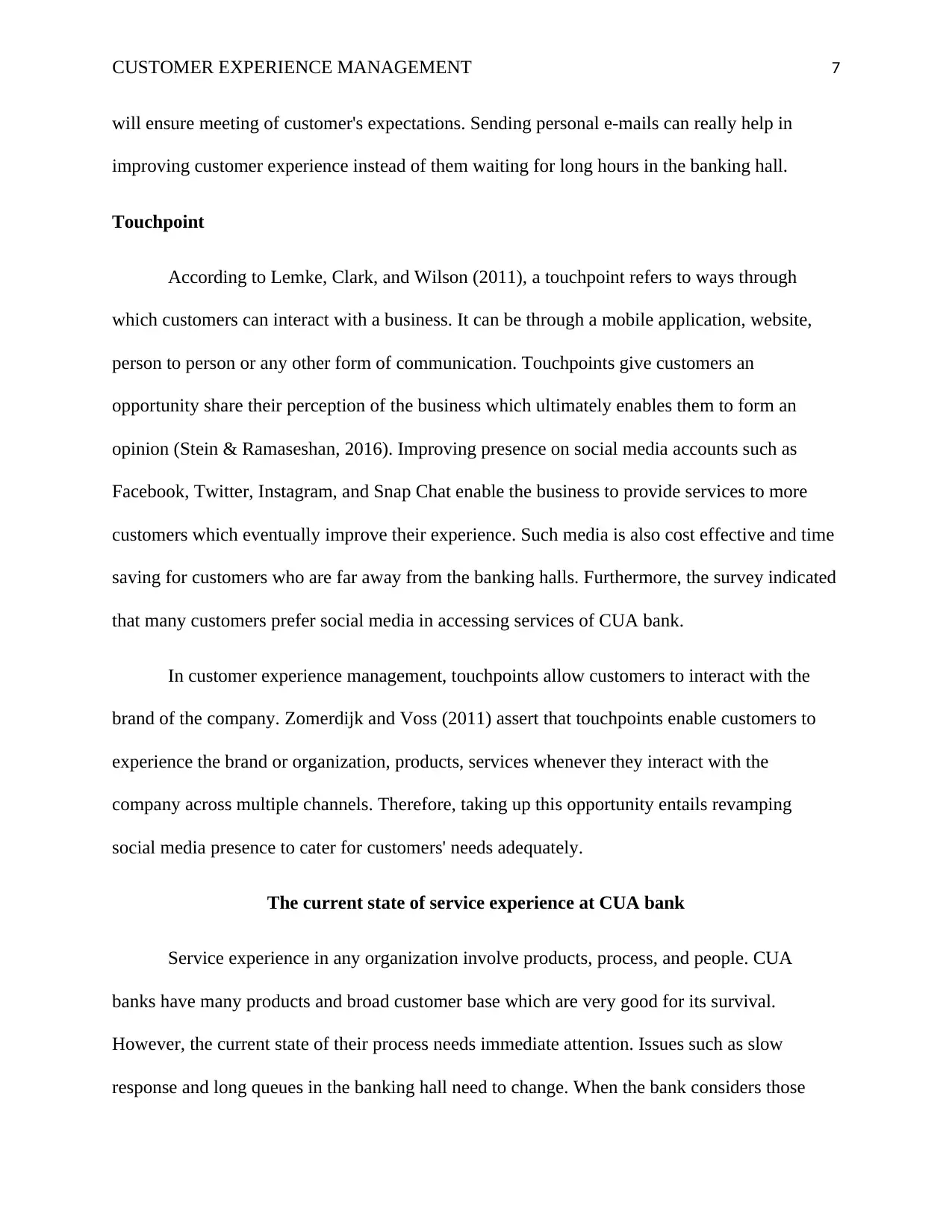
CUSTOMER EXPERIENCE MANAGEMENT 7
will ensure meeting of customer's expectations. Sending personal e-mails can really help in
improving customer experience instead of them waiting for long hours in the banking hall.
Touchpoint
According to Lemke, Clark, and Wilson (2011), a touchpoint refers to ways through
which customers can interact with a business. It can be through a mobile application, website,
person to person or any other form of communication. Touchpoints give customers an
opportunity share their perception of the business which ultimately enables them to form an
opinion (Stein & Ramaseshan, 2016). Improving presence on social media accounts such as
Facebook, Twitter, Instagram, and Snap Chat enable the business to provide services to more
customers which eventually improve their experience. Such media is also cost effective and time
saving for customers who are far away from the banking halls. Furthermore, the survey indicated
that many customers prefer social media in accessing services of CUA bank.
In customer experience management, touchpoints allow customers to interact with the
brand of the company. Zomerdijk and Voss (2011) assert that touchpoints enable customers to
experience the brand or organization, products, services whenever they interact with the
company across multiple channels. Therefore, taking up this opportunity entails revamping
social media presence to cater for customers' needs adequately.
The current state of service experience at CUA bank
Service experience in any organization involve products, process, and people. CUA
banks have many products and broad customer base which are very good for its survival.
However, the current state of their process needs immediate attention. Issues such as slow
response and long queues in the banking hall need to change. When the bank considers those
will ensure meeting of customer's expectations. Sending personal e-mails can really help in
improving customer experience instead of them waiting for long hours in the banking hall.
Touchpoint
According to Lemke, Clark, and Wilson (2011), a touchpoint refers to ways through
which customers can interact with a business. It can be through a mobile application, website,
person to person or any other form of communication. Touchpoints give customers an
opportunity share their perception of the business which ultimately enables them to form an
opinion (Stein & Ramaseshan, 2016). Improving presence on social media accounts such as
Facebook, Twitter, Instagram, and Snap Chat enable the business to provide services to more
customers which eventually improve their experience. Such media is also cost effective and time
saving for customers who are far away from the banking halls. Furthermore, the survey indicated
that many customers prefer social media in accessing services of CUA bank.
In customer experience management, touchpoints allow customers to interact with the
brand of the company. Zomerdijk and Voss (2011) assert that touchpoints enable customers to
experience the brand or organization, products, services whenever they interact with the
company across multiple channels. Therefore, taking up this opportunity entails revamping
social media presence to cater for customers' needs adequately.
The current state of service experience at CUA bank
Service experience in any organization involve products, process, and people. CUA
banks have many products and broad customer base which are very good for its survival.
However, the current state of their process needs immediate attention. Issues such as slow
response and long queues in the banking hall need to change. When the bank considers those
Paraphrase This Document
Need a fresh take? Get an instant paraphrase of this document with our AI Paraphraser
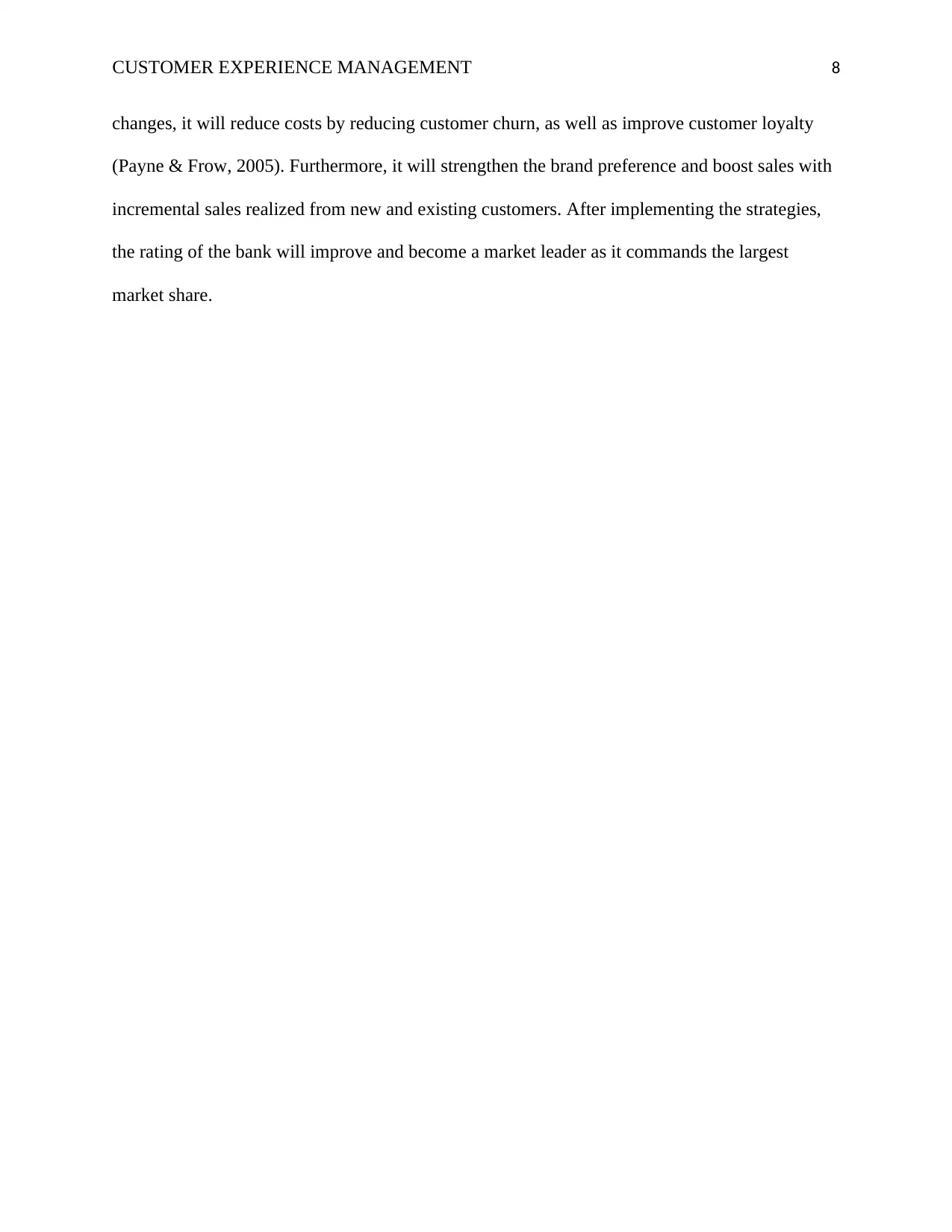
CUSTOMER EXPERIENCE MANAGEMENT 8
changes, it will reduce costs by reducing customer churn, as well as improve customer loyalty
(Payne & Frow, 2005). Furthermore, it will strengthen the brand preference and boost sales with
incremental sales realized from new and existing customers. After implementing the strategies,
the rating of the bank will improve and become a market leader as it commands the largest
market share.
changes, it will reduce costs by reducing customer churn, as well as improve customer loyalty
(Payne & Frow, 2005). Furthermore, it will strengthen the brand preference and boost sales with
incremental sales realized from new and existing customers. After implementing the strategies,
the rating of the bank will improve and become a market leader as it commands the largest
market share.
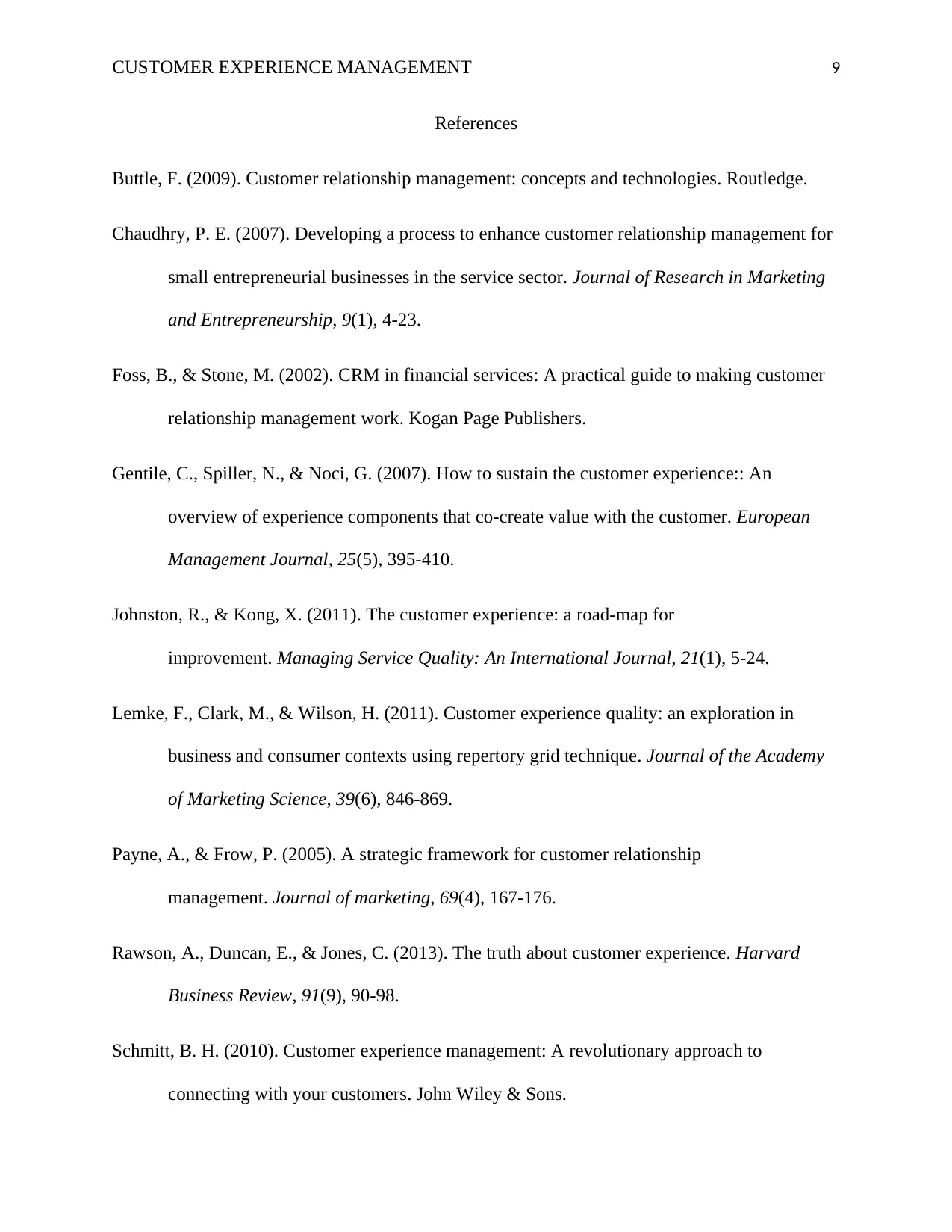
CUSTOMER EXPERIENCE MANAGEMENT 9
References
Buttle, F. (2009). Customer relationship management: concepts and technologies. Routledge.
Chaudhry, P. E. (2007). Developing a process to enhance customer relationship management for
small entrepreneurial businesses in the service sector. Journal of Research in Marketing
and Entrepreneurship, 9(1), 4-23.
Foss, B., & Stone, M. (2002). CRM in financial services: A practical guide to making customer
relationship management work. Kogan Page Publishers.
Gentile, C., Spiller, N., & Noci, G. (2007). How to sustain the customer experience:: An
overview of experience components that co-create value with the customer. European
Management Journal, 25(5), 395-410.
Johnston, R., & Kong, X. (2011). The customer experience: a road-map for
improvement. Managing Service Quality: An International Journal, 21(1), 5-24.
Lemke, F., Clark, M., & Wilson, H. (2011). Customer experience quality: an exploration in
business and consumer contexts using repertory grid technique. Journal of the Academy
of Marketing Science, 39(6), 846-869.
Payne, A., & Frow, P. (2005). A strategic framework for customer relationship
management. Journal of marketing, 69(4), 167-176.
Rawson, A., Duncan, E., & Jones, C. (2013). The truth about customer experience. Harvard
Business Review, 91(9), 90-98.
Schmitt, B. H. (2010). Customer experience management: A revolutionary approach to
connecting with your customers. John Wiley & Sons.
References
Buttle, F. (2009). Customer relationship management: concepts and technologies. Routledge.
Chaudhry, P. E. (2007). Developing a process to enhance customer relationship management for
small entrepreneurial businesses in the service sector. Journal of Research in Marketing
and Entrepreneurship, 9(1), 4-23.
Foss, B., & Stone, M. (2002). CRM in financial services: A practical guide to making customer
relationship management work. Kogan Page Publishers.
Gentile, C., Spiller, N., & Noci, G. (2007). How to sustain the customer experience:: An
overview of experience components that co-create value with the customer. European
Management Journal, 25(5), 395-410.
Johnston, R., & Kong, X. (2011). The customer experience: a road-map for
improvement. Managing Service Quality: An International Journal, 21(1), 5-24.
Lemke, F., Clark, M., & Wilson, H. (2011). Customer experience quality: an exploration in
business and consumer contexts using repertory grid technique. Journal of the Academy
of Marketing Science, 39(6), 846-869.
Payne, A., & Frow, P. (2005). A strategic framework for customer relationship
management. Journal of marketing, 69(4), 167-176.
Rawson, A., Duncan, E., & Jones, C. (2013). The truth about customer experience. Harvard
Business Review, 91(9), 90-98.
Schmitt, B. H. (2010). Customer experience management: A revolutionary approach to
connecting with your customers. John Wiley & Sons.
⊘ This is a preview!⊘
Do you want full access?
Subscribe today to unlock all pages.

Trusted by 1+ million students worldwide
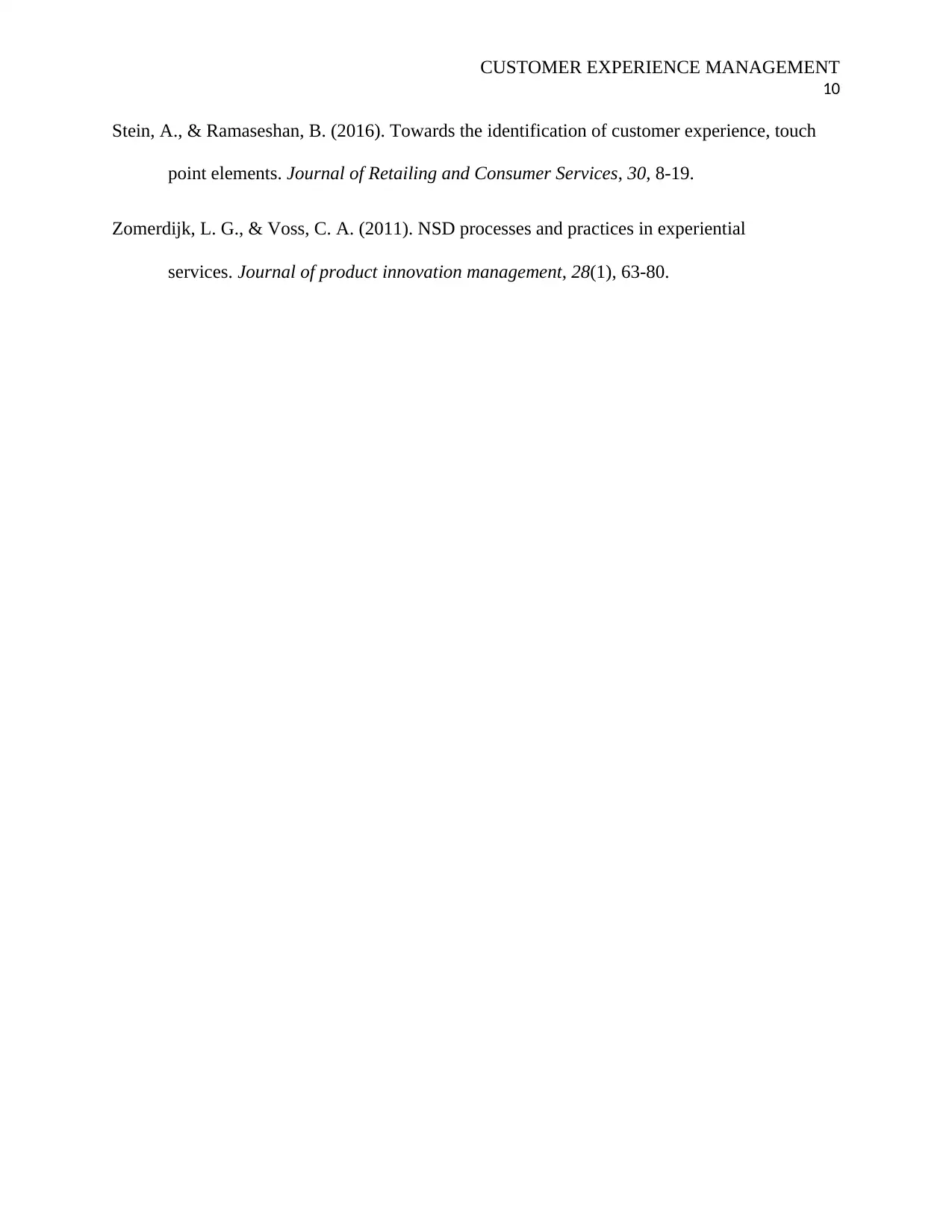
CUSTOMER EXPERIENCE MANAGEMENT
10
Stein, A., & Ramaseshan, B. (2016). Towards the identification of customer experience, touch
point elements. Journal of Retailing and Consumer Services, 30, 8-19.
Zomerdijk, L. G., & Voss, C. A. (2011). NSD processes and practices in experiential
services. Journal of product innovation management, 28(1), 63-80.
10
Stein, A., & Ramaseshan, B. (2016). Towards the identification of customer experience, touch
point elements. Journal of Retailing and Consumer Services, 30, 8-19.
Zomerdijk, L. G., & Voss, C. A. (2011). NSD processes and practices in experiential
services. Journal of product innovation management, 28(1), 63-80.
1 out of 10
Related Documents
Your All-in-One AI-Powered Toolkit for Academic Success.
+13062052269
info@desklib.com
Available 24*7 on WhatsApp / Email
![[object Object]](/_next/static/media/star-bottom.7253800d.svg)
Unlock your academic potential
Copyright © 2020–2025 A2Z Services. All Rights Reserved. Developed and managed by ZUCOL.



![COMM 6002 Business Communication Email Assignment - [University Name]](/_next/image/?url=https%3A%2F%2Fdesklib.com%2Fmedia%2Fimages%2Fhj%2F16fff807dbdb48489114c2cc77d0f68c.jpg&w=256&q=75)